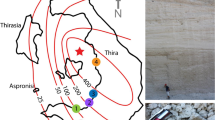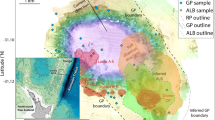Abstract
Measurements of H and V (dimensions in the horizontal and vertical directions of pillows exposed in vertical cross-section) were made on 19 pillow lavas from the Azores, Cyprus, Iceland, New Zealand, Tasmania, the western USA and Wales. The median values of H and V plot on a straight line that defines a spectrum of pillow sizes, having linear dimensions five times greater at one end than at the other, basaltic toward the small-size end and andesitic toward the large-size end. The pillow median size is interpreted to reflect a control exercised by lava viscosity. Pillows erupted on a steep flow-foot slope in lava deltas can, however, have a significantly smaller size than pillows in tabular pillowed flows (inferred to have been erupted on a small depositonal slope), indicating that the slope angle also exercised a control. Pipe vesicles, generally abundant in the tabular pillowed flows and absent from the flow-foot pillows, have potential as a paleoslope indicator. Pillows toward the small-size end of the spectrum are smooth-surfaced and grew mainly by stretching of their skin, whereas disruption of the skin and spreading were important toward the large-size end. Disruption involved increasing skin thicknesses with increasing pillow size, and pillows toward the large-size end are more analogous with toothpaste lava than with pahoehoe and are inferred from their thick multiple selvages to have taken hours to grow. Pseudo-pillow structure is also locally developed. An example of endogenous pillow-lava growth, that formed intrusive pillows between ‘normal’ pillows, is described from Sicily. Isolated pillow-like bodies in certain andesitic breccias described from Iceland were previously interpreted to be pillows but have anomalously small sizes for their compositions; it is now proposed that they may lack an essential attribute of pillows, namely, the development of bulbous forms by the inflation of a chilled skin, and are hence not true pillows. Para-pillow lava is a common lava type in the flow-foot breccias. It forms irregular flow-sheets that are locally less than 5 cm thick, and failed to be inflated to pillows perhaps because of an inadequate lava-supply rate or too high a flow velocity.
Similar content being viewed by others
References
Ballard RD, Moore JG (1977) Photographic atlas of the Mid-Atlantic Ridge rift valley. New York, Springer-Verlag
Baragar WRA (1984) Pillow formation and layered flows in the Circum-Superior Belt of eastern Hudson Bay. Can J Earth Sci 21:781–792
Bartrum JA (1930) Pillow-lavas and columnar fan-structures at Muriwai, Auckland, New Zealand. J Geol 38:447–455
Busby-Spera CJ (1987) Lithofacies of deep marine basalts emplaced on a Jurassic backarc apron, Baja, California (Mexico). J Geol 95:671–686
Dimroth E, Cousineau P, Leduc M, Sanschagrin Y (1978) Structure and organization of Archean subaqueous basalt flows, Rouyn-Noranda area, Quebec, Canada. Can J Earth Sci 15:902–918
Fridleifsson IB, Furnes H, Atkins FB (1982) Subglacial volcanics —on the control of magma chemistry on pillow dimensions. J Volcan Geotherm Res 13:103–117
Francis PW, Roobol MJ, Walker GPL, Cobbold PR, Coward M (1974) The San Pedro and San Pablo volcanoes of northern Chile and their hot avalanche deposits. Geol Rundsch 63:357–388
Fuller RE (1932) Tensional features of certain basaltic ellipsoids. J Geol 40:164–170
Furnes H, Fridleifsson IB (1978) Relationship between chemistry and axial dimensions of alkali olivine basaltic and olivine tholeiitic pillow lava. Bull Volcanol 41:136–146
Furnes H, Lippard SJ (1979) On the significance of Caledonian pahoehoe, aa, and pillow lava from Bømlo, SW Norway. Norsk Geol Tidskrift 59:107–114
Furnes H, Fridleifsson IB, Atkins FB (1980) Subglacial volcanics —on the formation of acid hyaloclastites. J Volcan Geotherm Res 8:95–110
Hargreaves R, Ayres LD (1979) Morphology of Archean metabasalt flows, Utik Lake, Manitoba, Can J Earth Sci 16:1452–1466
Hayward BW (1976) Lower Miocene geology and sedimentary history of the Muriwai-Te Waharoa coastline, North Auckland, New Zealand. NZ J Geol Geophys 19:639–662
Jones JG (1968) Pillow lava and pahoehoe. J Geol 76:485–488
Jones JG (1969) Intraglacial volcanoes of the Laugarvatn region, south-west Iceland-I. Geol Soc London Quart J 124:197–211
Jones JG (1970) Intraglacial volcanoes of the Laugarvatn region, Southwest Iceland, II. J Geol 78:127–140
Kawachi Y, Pringle IJ (1988) Multiple-rind structure in pillow lava as an indicator of shallow water. Bull Volcanol 50:161–168
Lewis JV (1914) Origin of pillow lavas. Geol Soc Am Bull 25:591–654
Macdonald GA (1972) Volcanoes. Englewood Cliffs, New Jersey. Prentice Hall, 510 pp
Mathews WH, Thorarinsson S, Church NB (1964) Gravitative settling of olivine in pillows of an Icelandic basalt. Am J Sci 262:1036–1040
Moore JG (1975) Mechanism of formation of pillow lava. Am Scient 63:269–277
Moore JG (1987) Subsidence of the Hawaiian Ridge. US Geol Surv Prof Pap 1350:85–100
Moore JG, Charlton DW (1984) Ultrathin lava layers exposed near San Luis Obispo Bay, California. Geology 12:542–545
Moore JG, Lockwood JR (1978) Spreading cracks on pillow lava. J Geol 86:661–671
Philpotts AR, Lewis CL (1987) Pipe vesicles — an alternate model for their origin. Geology 15:971–974
Rowland SK, Walker GPL (1987) Toothpaste lava: characteristics and origin of a lava structural type distinct from pahoehoe and aa. Bull Volcanol 49:577–587
Serralheiro A, de M Alves CA, Forjaz VH, Rodrigues EB (1987) Carta Vulcanologia dos Acores. Ilha de Santa Maria, 1:15000. Universide de Acores, Ponta Delgada
Shrock RR (1948) Sequence in layered rocks. New York, McGraw-Hill. 507 pp
Snavely PD (1987) Depoe Bay, Oregon. Geol Soc Am Centennial Field Guide — Cordilleran Section 307–310
Snavely PD, MacLeod NS, Wagner HC (1973) Miocene tholeiitic basalts of coastal Oregon and Washington and their relations to coeval basalts of the Columbia Plateau. Geol Soc Am Bull 84:387–424
Snyder GL, Fraser GD (1963) Pillowed lavas. I. Intrusive layered lava pods and pillowed lavas, Unalaska Island, Alaska. US Geol Surv Prof Pap 454-B:23 pp
Solomon M (1969) The nature and possible origin of the pillow lavas and hyaloclastite breccias of King Island, Australia. Geol Soc London Quart J 124:159–169
Staudigel H, Schmincke H-U (1984) The Pliocene seamount series of La Palma/Canary Islands. J Geophys Res 89:11195–11215
Tepley L, Moore JG (1974) Fine under the sea: the origin of pillow lava (16 mm motion picture). Mountain View, Calif, Moonlight Productions
Thomas GE, Thomas TM (1955) The volcanic rocks of the area between Fishguard and Strumble Head, Pembrokeshire. Geol Soc London Quart J 112:291–317
Tribble GW (1991) Underwater observation of active lava flows from Kilauea Volcano, Hawaii. Geology 19:633–636
Uttley GH (1918) The volcanic rocks of Oamaru, whith special reference to their position in the stratigraphial series. NZ Inst Trans Proc 50:106–117
Vuagnat M (1975) Pillow lava flows: isolated sacks or connected tubes? Bull Volcanol 39:581–589
Vuagnat M, Pustaszeri L (1965) Réflexions sur la structure et le mode de formation des coulées en coussins du Montgenèvre (Hautes-Alpes). Archives Sci (Geneva) 18:686–689
Wahrhaftig C, Murchey B (1987) Marin Headlands, California: 100-million-year record of seafloor transport and accretion. Geol Soc Am Centennial Field Guide — Cordilleran Section 263–268
Walker GPL (1970) Compound and simple lava flows and flood basalts. Bull Volcanol 35:579–590
Walker GPL (1987) Pipe vesicles in Hawaiian basaltic lavas: their origin and potential as paleoslope indicators. Geology 15:84–87
Watanabe K, Katsui Y (1976) Pseudo-pillow lavas in the Aso caldera, Kyushu, Japan. J Jap Assoc Min Pet Econ Geol 71:44–49
Wells G, Bryan WB, Pearce TH (1979) Comparative morphology of ancient and modern pillow lavas. J Geol 87:427–440
Wilson ME (1942) Structural features of the Keewatin volcanic rocks of western Quebec. Geol Soc Am Bull 53:53–69
Yagi K (1964) Pillow lavas of Keflavik, Iceland and their genetic significance. Hokkaido Univ Fac Sci J ser 4, 12:171–183
Yagi K (1965) Gravitative settling of olivine in pillows of an Icelandic basalt. Discussion. Am J Sci 263:914–916
Yagi K (1969) Petrology of the alkalic dolerites of the Nemuru Peninsula, Japan. Geol Soc Am Mem 115:103–147
Yamagishi H (1985) Growth of pillow lobes-evidence from pillow lavas of Hokkaido, Japan, and North Island, New Zealand. Geology 13:499–502
Author information
Authors and Affiliations
Rights and permissions
About this article
Cite this article
Walker, G.P.L. Morphometric study of pillow-size spectrum among pillow lavas. Bull Volcanol 54, 459–474 (1992). https://doi.org/10.1007/BF00301392
Received:
Accepted:
Issue Date:
DOI: https://doi.org/10.1007/BF00301392




